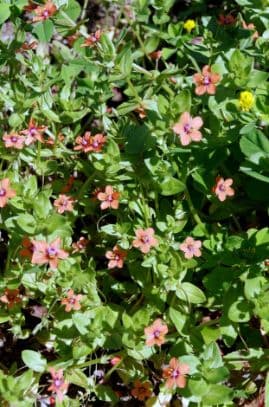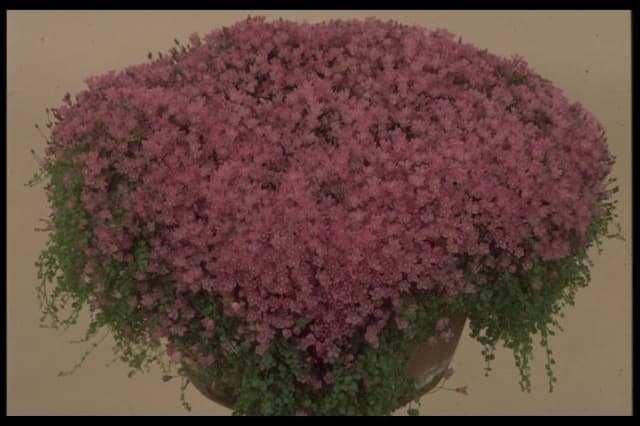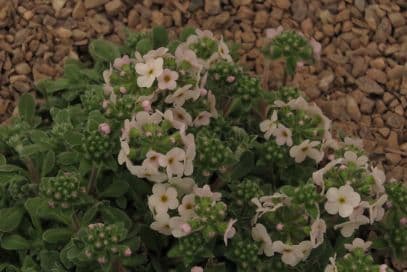Primrose Primula secundiflora (Pf)

ABOUT
Primula secundiflora, commonly known as the Primrose, is a herbaceous plant that is known for its attractive appearance. The plant has a rosette of leaves at the base, which are typically green, and can have a slightly wrinkled or textured surface. It produces flowers that rise above the foliage on stalks, and these blooms are distinctly shaped with petals that are fused at their base to form a tube. The flowers then spread out into a flat face with five rounded lobes. The coloring of Primula secundiflora flowers can vary, with hues that are often bright and eye-catching. The overall impression of the Primrose is a delicate and ornamental plant which is often found in garden settings due to its beautiful and charming flowers.
About this plant
 Names
NamesFamily
Primulaceae
Synonyms
Incense Primrose
Common names
Primula secundiflora.
 Toxicity
ToxicityTo humans
Primula secundiflora, commonly known as Chinese primrose, is not listed as a highly toxic plant to humans. However, all Primula species contain compounds known as primin and other related compounds, which can cause contact dermatitis in sensitive individuals. Ingesting parts of the plant might potentially cause mild stomach upset. However, serious poisoning is rare, and symptoms might include nausea, vomiting, or diarrhea if significant amounts are ingested.
To pets
Primula secundiflora, or Chinese primrose, is not commonly listed as a highly toxic plant for pets. Nevertheless, Primula species can cause mild gastrointestinal upset if ingested by animals such as vomitíng and diarrhea. Primula species have also been known to cause dermatitis in some pets, primarily through skin contact. It is advisable to prevent pets from ingesting the plant and to monitor for any signs of discomfort if ingestion does occur.
 Characteristics
CharacteristicsLife cycle
Perennials
Foliage type
Deciduous
Color of leaves
Green
Flower color
Pink
Height
1 foot (0.3 meters)
Spread
1 foot (0.3 meters)
Plant type
Herb
Hardiness zones
7
Native area
China
Benefits
 General Benefits
General Benefits- Ornamental Value: Primula secundiflora, commonly known as "creeping primrose," adds aesthetic appeal to gardens with its attractive flowers and foliage.
- Habitat Support: Provides nectar for pollinators such as bees, butterflies, and other beneficial insects which are essential for the ecosystem.
- Low Maintenance: Creeping primrose is considered easy to grow and requires minimal upkeep, making it suitable for novice gardeners.
- Tolerance to Conditions: It can tolerate partial shade, making it versatile for different garden settings.
- Seasonal Interest: Offers a seasonal display of flowers typically in spring, adding color and vibrancy to garden landscapes.
- Soil Erosion Control: The plant's growth habit can help stabilize soil and reduce erosion on slopes or in areas of loose ground.
- Companion Planting: Creeping primrose can be used in companion planting to complement and enhance the growth of other garden plants.
 Medical Properties
Medical Properties- Antitussive - Primula secundiflora has been traditionally used to alleviate coughs.
- Expectorant - It is believed to aid in expelling phlegm from the respiratory tract.
- Anti-inflammatory - The plant may have properties that help reduce inflammation in the body.
- Diuretic - Primula secundiflora might be utilized for increasing the production of urine to aid in the removal of excess fluids from the body.
 Air-purifying Qualities
Air-purifying QualitiesThis plant is not specifically known for air purifying qualities.
 Other Uses
Other Uses- Decoration in miniature gardens: Due to its compact size, Primula secundiflora can be used as a decorative element in fairy gardens and terrariums.
- Seasonal crafts: The flowers of Primula secundiflora can be pressed and used in creating floral bookmarkers, greeting cards, or other paper crafts for a natural aesthetic.
- Photography subject: Its vibrant flowers make Primula secundiflora a popular subject for photographers practicing macro photography techniques.
- Educational tool: Botany students can study Primula secundiflora to understand flower structure, especially the unique arrangement of its blooms.
- Research on plant pigments: The vivid colors of Primula secundiflora's flowers can be used in research to study plant pigmentation and genetics.
- Live plant in insectariums: It can be used as part of living exhibits in butterfly houses or insectariums, providing nectar for various insects.
- Color inspiration: Artists can take inspiration from the rich hues of Primula secundiflora for color palettes in paintings, textiles, or interior décor.
- Culinary presentations: Edible varieties of Primula flowers, though not specifically secundiflora, are sometimes crystallized or used fresh to garnish salads and desserts.
- Cultural practices: In some regions, flowers similar to Primula secundiflora might be used in festivals or ceremonies to denote certain seasons or themes.
- Botanical art: Primula secundiflora can be a muse for botanical illustrators or those specializing in detailed scientific plant drawings.
Interesting Facts
 Feng Shui
Feng ShuiThe Primrose is not used in Feng Shui practice.
 Zodiac Sign Compitability
Zodiac Sign CompitabilityThe Primrose is not used in astrology practice.
 Plant Symbolism
Plant Symbolism- Youthful Charm: As with many primulas, Primula secundiflora, commonly known as the Incense Primrose, is often associated with the early days of spring and therefore symbolizes the vigor and innocent allure of youth.
- Hope and Renewal: The Incense Primrose emerges after the winter, representing the idea of renewed hope and the fresh start that comes with the arrival of spring.
- Persistence: This particular species can thrive in alpine climates, suggesting the trait of persistence and the ability to endure challenging conditions.
- Diversity: Primula secundiflora comes in various colors, symbolizing diversity and inclusivity.
- Affection and Attachment: In the language of flowers, primroses can imply a kind of affection or fond attachment, meaning that the giver is enchanted by the recipient with a child-like and pure love.
 Water
WaterFor the Chinese Primrose, water thoroughly when the top inch of the soil feels dry to the touch, which may be roughly every week, although this will depend on environmental conditions like humidity and temperature. Provide enough water to moisten the soil all the way through, but avoid letting the plant sit in water, which can lead to root rot. In general, it may need about 16 ounces of water per watering session, but this amount could be less during the winter months when the plant is not actively growing.
 Light
LightThe Chinese Primrose thrives in bright, indirect light away from direct sunlight that can scorch its leaves. A north-facing window or a spot that receives filtered light is ideal for this plant. Avoid placing it in full shade, as this might hinder its growth and flowering potential.
 Temperature
TemperatureChinese Primrose prefers cool to moderate temperatures, thriving best when the temperature is between 60 to 75 degrees Fahrenheit. It can handle minimum temperatures down to 50 degrees Fahrenheit. Avoid exposing the plant to temperatures above 80 degrees Fahrenheit, as it may cause stress and damage.
 Pruning
PruningPruning the Chinese Primrose involves removing dead or fading flowers to encourage more blooms and maintain a neat appearance. This should be done as needed throughout the blooming season. The best time to prune is after the main flowering period is over to tidy the plant and stimulate new growth.
 Cleaning
CleaningAs needed
 Soil
SoilChinese Primrose prefers a well-draining, humus-rich mix with a slightly acidic to neutral soil pH of 6.0 to 7.0. A mixture of peat, loam, and perlite or sand is ideal for good root health and moisture retention, with added compost for fertility.
 Repotting
RepottingChinese Primrose should be repotted every one to two years to replenish the soil and provide room for growth. Choose a slightly larger pot to prevent crowding of the roots.
 Humidity & Misting
Humidity & MistingChinese Primrose thrives in moderate to high humidity, ideally between 50-60%. Avoid environments that are too dry, as this can lead to stress and poor health for the plant.
 Suitable locations
Suitable locationsIndoor
Place in bright, indirect light and keep soil moist.
Outdoor
Use partial shade and moist, well-drained soil.
Hardiness zone
3-8 USDA
 Life cycle
Life cyclePrimula secundiflora, also known as the Cliff Cowslip, begins its life cycle as a seed, typically germinating in the spring when conditions are moist and cool. After germination, the seedling develops into a rosette of leaves close to the ground, gradually maturing into a full-fledged vegetative state. As it grows, the plant forms a stout flowering stem, and in late spring to early summer, it produces a series of tubular flowers that are typically arranged in a one-sided manner, giving rise to its species name. Once pollinated, possibly by insects attracted to its vivid colors, the flowers develop into capsules containing numerous tiny seeds. These seeds disperse in the environment, either by wind, water, or passing animals, completing the reproductive stage. In the subsequent seasons, the Cliff Cowslip enters a period of dormancy during colder months, resuming growth as temperatures rise, thus perpetually repeating its life cycle.
 Propogation
PropogationPropogation time
Spring to Summer
Primula secundiflora, commonly known as the Chinese primrose, is typically propagated through seed sowing. The best time for sowing seeds of Chinese primrose is late winter to early spring. To propagate by seeds, growers should gently press the seeds into the surface of a well-draining seed starting mix, ensuring not to cover them deeply as they require light for germination. The container with the seeds should be kept at a steady temperature of about 60-70 degrees Fahrenheit (15.6 - 21.1 degrees Celsius) and out of direct sunlight. Maintaining a consistent moisture level in the soil without causing waterlogging is crucial for successful germination. Once the seedlings have developed a couple of true leaves and are large enough to handle, they can be transplanted into individual pots or their final growing positions.









